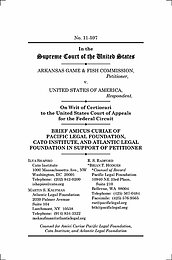Arkansas Game & Fish Commission v. United States
Learn more about Cato’s Amicus Briefs Program.
The Arkansas Game and Fish Commission owns and operates 23,000 acres of land as a wildlife refuge and recreational preserve; the preserve’s trees are essential to its use for these purposes. Clearwater Dam, a federal flood control project, lies 115 miles upstream. Water is released from the dam in quantities governed by a pre-approved “management plan” that considers agricultural, recreational, and other effects downstream. Between 1993 and 2000, the federal government released more water than authorized under the plan. AGFC repeatedly objected that these excess releases flooded the preserve during its growing season, which significantly damaged and eventually decimated tree populations. In 2001, the government acknowledged the havoc its flooding had wreaked on AGFC’s land and ceased plan deviations. By then, however, the preserve and its trees were severely damaged, so AGFC sued the government, claiming damages under the Fifth Amendment’s Takings Clause. The district court awarded $5.8 million in lost timber and reforestation costs based on the substantiality of the government’s flooding and the foreseeability of the damage it caused. The U.S. Court of Appeals for the Federal Circuit reversed that decision, holding that flooding can never be a taking unless that flooding is permanent. It further held that, in determining whether the government’s flooding was permanent or temporary, courts must focus on the character of the policy behind the intrusion rather the effects of the intrusion itself. A taking cannot have occurred here because each deviation from the plan constituted a “temporary” policy, the court concluded, so AGFC had no constitutional remedy. In December, Cato joined the Pacific Legal Foundation on an amicus brief urging the Supreme Court to take the case, which it did. Now Cato again joins the Pacific Legal Foundation, as well as the Atlantic Legal Foundation, in urging the Court to uphold the Fifth Amendment rights of property owners whose land is destroyed by the federal government. We argue that the length of time of the government’s physical invasion of property should not be used to determine whether a taking occurred, but rather only for calculating how much damage the taking caused. We further argue that the Federal Circuit’s focus on the “intent” of the government action—whether the flooding resulted from a “permanent or temporary policy”—is likewise irrelevant to whether a taking occurred. Instead, the inquiry should be whether the government caused permanent damage and, if so, how much. The lower court erroneously created a rule—that so long as it might be “temporary,” no government flooding can be remedied under the Fifth Amendment—that runs afoul of a constitutional provision meant to compensate property owners for government intrusions on their land.

This work is licensed under a Creative Commons Attribution-NonCommercial-ShareAlike 4.0 International License.


